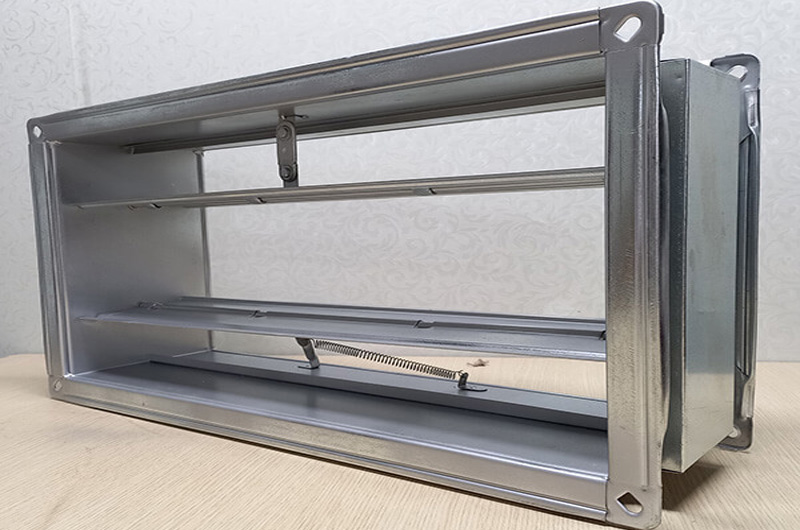
Thematic
Fire-resistant ventilation duct solution utilizing KH Shield insulation panel
The fire-resistant duct solution in the ventilation system is an indispensable component of any construction and residential building. This system operates based on key functions including air filtration, temperature regulation, and the provision of fresh oxygen. Up until the current time, the ventilation system of a structure must also simultaneously meet the fire resistance standards set forth by the government.
Consequently, the requirements for the fireproof and thermal insulation capabilities of each component within the system have been significantly elevated. Notable examples include fire dampers and fire-resistant duct solutions.
Government regulations regarding the standards for fire-resistant ducts

Fire-resistant duct solutions and government regulations
According to Standard QCVN 06:2021/BXD issued in 2021, the smoke extraction components in the ventilation system must be made from fire-resistant materials and meet the minimum fire resistance capability as stipulated.
At different positions, the fire resistance standards for ducts will also be at different levels. Most prominently among them are the EI standards for fire resistance, most commonly: EI30, EI45, EI60, EI120, and EI180. These are standards that evaluate the fire resistance time (measured in minutes) from the start of combustion until the product exhibits deformation, indicating integrity (E) and thermal insulation (I) properties.
The EI fire resistance standards are applied in specific duct installation locations as follows:
- EI30 Fire-Resistant Duct: Applied to ducts placed in corridors with a horizontal orientation and ducts crossing doorways.
- EI45 Fire-Resistant Duct: Applied to ducts installed in a vertical orientation.
- EI60 Fire-Resistant Duct: Applied to horizontally oriented ducts in basements, parking levels, and horizontally oriented pressure-increasing ducts.
- EI120 Fire-Resistant Duct: Applied to horizontally oriented ducts outside the fire compartment and vertically oriented pressure-increasing ducts.
- EI120 Fire-Resistant Duct: Applied to vertically oriented ducts in basements and parking levels.
Selection of fire-resistant materials for fire-resistant ducts

Fire-resistant materials applied in fire-resistant duct solutions
The fire resistance capability of ducts depends on the quality of fire-resistant materials applied in the product. The better the fire-resistant materials, the more they ensure compliance with fire safety standards and provide safety for human lives. The following factors can be noted when selecting an appropriate type of fire-resistant material:
Choosing reputable material suppliers
Fire-resistant materials must meet standards through sample burning tests and rigorous quality assessments at authorized state agencies. However, before individual product certification is achieved, material suppliers must obtain general certification for their entire production facility.
As a result, fire-resistant material suppliers must be reputable entities, holding quality assurance certifications for fire-resistant materials, and being licensed by the government.
Selection based on quality criteria
In today’s market, there are many types of fire-resistant materials suitable for fire-resistant duct solutions. Among them, fire-resistant materials should meet certain criteria, including:
- Fire prevention and insulation capability: Users should be aware of the EI standard achieved by the fire-resistant material, ranging from at least EI 30 minutes to EI 180 minutes.
- Material density: Fire-resistant materials need to have a lightweight density to align with the function of fire-resistant ducts and not increase the load pressure on supporting components.
- Non-toxicity: Users should avoid fire-resistant materials that release harmful toxins detrimental to human health, such as formaldehyde.
Application of KH Shield insulation panel for fire-resistant ducts

Application of KHS.HF.M Insulation Panel in Fire-Resistant Duct Solutions
The fire-resistant duct solution incorporates the KHS.HF.M insulation panel from KH Shield Corporation, offering superior fire prevention and insulation features compared to traditional products.
The exclusive FireShieldPRO® technology used in manufacturing the KHS.HF.M insulation panel brings numerous advantages:
- 3-hour usability: Withstanding temperatures of up to 1000 degrees Celsius, the KHS.HF.M insulation panel maintains its usability for a continuous 3-hour duration upon contact.
- No generation of black smoke: In the event of a fire, the KHS.HF.M insulation panel does not produce harmful black smoke for those inside.
- Environmentally friendly: FireShieldPRO® is a green technology, eco-friendly, non-polluting, and infinitely recyclable.
- Meets quality inspection standards: The KHS.HF.M insulation panel performs well and is suitable for use in all situations, meeting the state’s fire safety standards for construction.
In the context of fire-resistant duct solutions, the KHS.HF.M insulation panel has various applications, including:
- Emergency ventilation systems: Employed in systems designed to mitigate emergencies like fires or chemical spills.
- Kitchen smoke extraction: Applied in ducts for removing smoke from household kitchens during cooking.
- Positive pressure ventilation systems: Utilized in positive pressure ventilation systems for large construction projects, residential complexes, or commercial buildings.
- Basement ventilation systems: Used in ventilation systems placed in basements and parking areas.
The fire-resistant duct solution employing the KHS.HF.M insulation panel is an optimal choice for enhancing fire prevention and insulation capabilities within building ventilation systems. Furthermore, this choice optimizes costs and ensures high efficiency throughout its usage.
Update the latest topic
Update highlights

Consultation on fire and explosion prevention solutions














